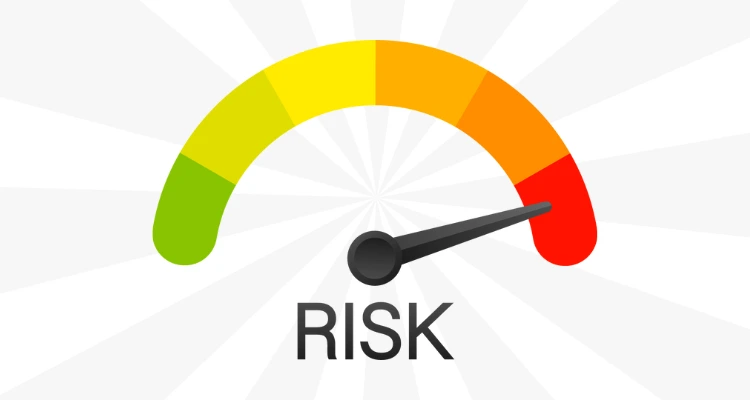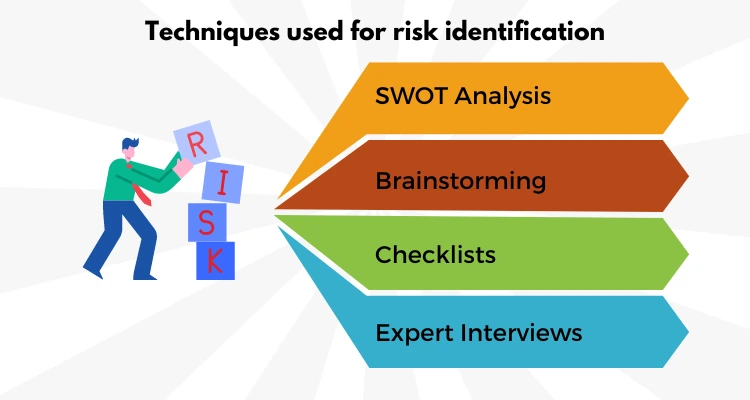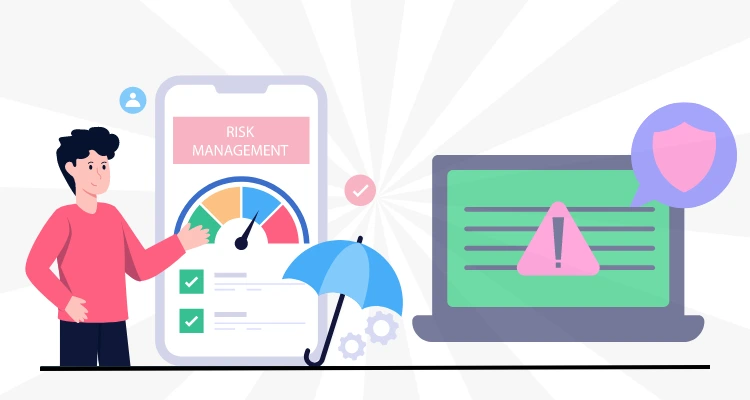- Home
- -Blog
Top Interview Questions on Risk Management in Software Development

- Updated on 07 Oct 2024
- Shabir Ahmad
Top Interview Questions on Risk Management in Software Development
In the swiftly evolving world of software development, risk management stands as a critical discipline, ensuring projects meet their timelines, budgets, and quality standards. With the rapid acceleration of digital transformation, the stakes have never been higher.
According to PMI's 2021 Pulse of the Profession report, 32% of project failures are attributed to inaccurate risk management, underscoring the importance of this skill in the field.
Navigating the minefield of potential setbacks requires a risk manager not only to anticipate problems but also to communicate effectively and make pivotal decisions. As such, interviews for risk management positions in software development are designed to probe a candidate's technical acumen, experience, and behavioral aptitude.
By understanding these questions and why employers ask them, candidates can walk into interviews with a solid foundation of knowledge, use helpful interview prep tools, and gain the confidence to tackle complex risk scenarios. Let's dive into the world of risk management in software development and unlock the strategies for ace your next interview.
General Risk Management Interview Questions and Answers

Risk Management: A Crucial Safety Net in Software Development
Every software development project is a unique venture into potentially uncharted territories of technology and teamwork. With each line of code, there lies the potential for bugs, and with every update, a chance for unforeseen complications. This is where risk management becomes the linchpin of project stability and success. In interviews for risk management roles within software development, you can expect to tackle questions that test not only your technical know-how but also your strategic thinking and experience.
-
Can you explain Risk Management and why it is important for organizations?
-
What are the steps involved in the risk management process?
- Risk Identification: Spotting and documenting potential risks.
- Risk Analysis: Understanding the nature of the risk and its potential impact on the project.
- Risk Prioritization: Determining which risks need immediate attention based on their impact and probability.
- Risk Mitigation: Implementing strategies to minimize the impact of risks.
- Risk Monitoring: Continuously checking for new risks and assessing the effectiveness of your mitigation strategies.
-
How would you prioritize risks in a project?
-
Can you describe some techniques you use for risk identification?
- SWOT Analysis: Identifying Strengths, Weaknesses, Opportunities, and Threats related to the project.
- Brainstorming: Gathering a diverse group of people to think about potential risks.
- Checklists: Using a pre-developed list of common risk sources.
- Expert Interviews: Consulting with individuals who have experience in similar projects.
-
What is 'risk appetite,' and how does it affect risk management?
-
How do you assess the potential impact of a risk?
-
What strategies would you employ for risk mitigation?
- Avoidance: Changing the project plan to eliminate the risk.
- Transfer: Shifting the risk to a third party, like insurance.
- Mitigation: Taking steps to reduce the impact or likelihood of the risk.
- Acceptance: Acknowledging the risk and choosing to deal with it if it occurs.
-
How do you communicate risk-related information to stakeholders?
- Regular Updates: Keeping stakeholders informed about the identification, analysis, and status of risks.
- Risk Reports: Creating documents that highlight current risks, their status, and actions taken.
- Meetings: Holding regular discussions with stakeholders to review risks and strategies.
-
How do you integrate risk management practices into agile software development methodologies?
-
What is your approach to managing risks associated with third-party vendors in software development?
-
Can you discuss a time when you had to manage risks in a cross-cultural or globally distributed team?
-
How do you handle ethical risks in software development projects?
Risk management is the process of identifying, analyzing, and responding to risk factors throughout the life of a project and in the best interests of its objectives. It's critical for organizations to practice effective risk management to prevent losses, safeguard assets, ensure regulatory compliance, and maintain a robust operational strategy.
The risk management process typically includes:
Risks are prioritized based on their likelihood of occurrence and the extent of their potential impact. High-likelihood, high-impact risks are given top priority, followed by risks with lower likelihood and impact. The prioritization process also considers factors like stakeholder tolerance and project constraints.
Several techniques are used for risk identification, including:

Risk appetite is the level of risk that an organization is willing to accept in pursuit of its objectives. It affects risk management by guiding the risk analysis and mitigation strategies. A higher risk appetite might mean pursuing innovative solutions that carry more risk, while a lower appetite will prioritize stability and caution.
The potential impact of a risk is assessed by considering its possible effects on project scope, schedule, budget, and quality. Both quantitative methods (like cost-impact analysis) and qualitative methods (like expert judgment) are used to determine the potential repercussions of each risk.
Risk mitigation strategies might include:
Effective communication about risks involves:
In agile environments, risk management is integrated into the iterative process. It involves regularly assessing risks during sprint planning and retrospectives. The key is to be adaptive and responsive.
For instance, if a sprint review reveals new risks, these are quickly incorporated into the risk register and addressed in the next sprint. This approach ensures that risk management is a continuous, integral part of the agile process.
Managing third-party vendor risks involves due diligence in selecting vendors, clear contractual agreements outlining risk responsibilities, and continuous monitoring. It's important to conduct regular assessments of the vendor's performance and compliance with agreed standards.
For example, if a vendor provides a critical component of your software, regular performance and security audits can help mitigate potential risks.
Managing risks in a cross-cultural or globally distributed team requires understanding and respecting different cultural perspectives on risk. Communication is key.
For example, in one of my previous roles, we had a distributed team across three continents. I ensured that all team members were aware of the risks and their impacts, regardless of location, by using clear, non-technical language and leveraging technology for effective communication. Regular virtual meetings and a shared risk management tool helped everyone stay aligned and responsive to emerging risks.
Ethical risks in software development, such as data privacy concerns or potential bias in AI algorithms, are handled by adhering to ethical guidelines and regulatory standards. It involves conducting thorough ethical impact assessments and involving stakeholders in discussions about potential ethical implications.
For instance, if a project involves user data, ensuring compliance with GDPR and other privacy regulations is crucial, alongside transparent user communication about data usage.
How do you manage risks in a rapidly evolving technology landscape, such as with emerging technologies like AI or blockchain?
Managing risks in rapidly evolving technologies requires staying informed about the latest developments and potential challenges. Continuous learning, attending industry conferences, and participating in professional networks are key.
When working with emerging technologies like AI, it's important to conduct scenario planning and have a flexible risk management approach that can adapt to new information or technological changes.
Technical Interview Questions in Risk Management
In this section, we'll cover some of the more technical interview questions that probe a candidate's specific knowledge and skills in applying risk management principles to software development.
Understanding Technical Risk in Software Development

Technical risks in software development can range from issues in code quality and integration challenges to technology obsolescence and security vulnerabilities. These questions are designed to assess how well a candidate can identify, analyze, and mitigate such risks.
- Risk Assessment Techniques in Software Projects
- Question:What methods do you use for technical risk assessment in software projects?
- Answer: I utilize a combination of quantitative and qualitative techniques, such as failure mode effects analysis (FMEA) for identifying potential points of failure, and probabilistic risk assessment for evaluating the likelihood and impact of those failures. Additionally, I often conduct code reviews and utilize static code analysis tools to identify potential security risks or code quality issues.
- Addressing Emerging Tech Risks
- Question: How do you manage risks associated with implementing new or emerging technologies in software projects?
- Answer: Managing risks with emerging technologies involves continuous learning and staying updated with the latest tech trends. I conduct thorough research and feasibility studies to understand the technology's maturity level, potential challenges, and its fit within the project. Pilot projects and proof of concepts are also crucial to evaluate the technology's practicality before full-scale implementation.
- Managing Security Risks in Software Development
- Question: Can you describe your approach to managing security risks in software development?
- Answer: Security risk management in software development starts with following secure coding practices and incorporating security into the design phase (Security by Design). I also ensure regular security audits, vulnerability assessments, and penetration testing are conducted. Additionally, staying informed about the latest security threats and updates is crucial for proactive management.
Tools and Techniques for Technical Risk Management
Modern software development risk management requires an array of tools and techniques. This section explores a candidate's familiarity and proficiency with these tools.
- Proficiency in Risk Management Tools
- Question:What risk management tools and software are you proficient in?
- Answer:I have experience with tools like JIRA for tracking risks and issues, Monte Carlo simulations for uncertainty analysis, and RiskyProject for advanced project risk management. I'm also familiar with various static code analysis tools that help in identifying potential risks in the codebase.
- Integrating Risk Management in Development Tools
- Question: How do you integrate risk management within the software development lifecycle?
- Answer: Risk management is integrated at every stage of the software development lifecycle. During the planning phase, risks are identified and assessed. In the development phase, continuous monitoring and code reviews help in early detection of risks. Post-deployment, risks are managed through regular monitoring and maintenance.
Advanced Technical Risk Management Questions
These questions aim to probe deeper into the candidate's technical expertise and ability to handle complex risk scenarios in software development.
- Dealing with Legacy Systems
- Question: How do you approach risk management when dealing with legacy systems in software projects?
- Answer: Managing risks in legacy systems involves a thorough assessment of the existing architecture and understanding its limitations. It's crucial to balance the need for modernization with the risks associated with integrating new technologies. I focus on gradual refactoring, ensuring compatibility, and conducting rigorous testing to mitigate risks during the transition phase.
- Integrating Risk Management in Development Tools
- Question: What is your approach to risk management in a DevOps environment?
- Answer: In a DevOps environment, where development and operations are closely integrated, I emphasize continuous risk assessment throughout the CI/CD pipeline. This includes automated security and compliance checks, regular code reviews, and close collaboration between development, operations, and security teams to identify and mitigate risks promptly.
- Managing Project Scope Risks
- Question: How do you handle risks related to project scope creep in software development?
- Answer: To manage scope-related risks, I ensure clear communication of project requirements and regular stakeholder meetings to track progress and changes. I also employ agile methodologies to accommodate changes flexibly while maintaining a clear focus on project objectives and deliverables.
- Risk Analysis in High-Stakes Projects
- Question: Can you describe your experience with risk analysis in high-stakes or high-pressure software projects?
- Answer: In high-stakes projects, my approach involves conducting a thorough risk assessment with a focus on worst-case scenarios. This includes identifying potential high-impact risks, running simulations, and preparing contingency plans. Stress-testing various aspects of the software under extreme conditions is also a key strategy.
Experience-related Risk Management Interview Questions and Answers
Continuing our series on "Top Interview Questions on Risk Management in Software Development," let's move to the next crucial part: Experience-related Risk Management Interview Questions and Answers. This section delves into real-world scenarios that candidates might have encountered, offering insights into their practical risk management skills.
Navigating Complex Risks in Software Projects
Real-world experience is invaluable in risk management, and interviewers often probe this aspect to understand a candidate's hands-on capabilities.
- Handling High-Pressure Situations
- Question: Describe how you managed a high-risk situation in a past software development project.
- Answer: A strong response should detail a specific project where the candidate identified a significant risk, such as a critical security vulnerability or a major integration issue. The candidate should explain their method for assessing the risk, the steps taken to mitigate it, and the successful outcome. This answer demonstrates the ability to respond effectively under pressure and implement practical solutions.
- Handling High-Pressure Situations
- Question: Can you share an experience where a risk management strategy you implemented did not work as planned?
- Answer: Candidates should discuss a scenario where despite their best efforts, a risk management strategy fell short. Importantly, they should focus on what they learned from this experience and how it informed their future approaches. This response highlights their ability to learn from mistakes and adapt their strategies accordingly.
- Risk Management in Agile Environments
- Question: How have you integrated risk management within an Agile software development process?
- Answer: Here, the candidate should describe how they adapt risk management practices to fit within Agile methodologies. This could include conducting risk assessments during sprint planning, integrating risk considerations into daily stand-ups, and ensuring continuous risk monitoring and adaptation throughout the development process.
Applying Advanced Risk Management Techniques
This section focuses on the candidate's ability to apply advanced risk management techniques in real-world scenarios.
- Advanced Risk Identification Techniques
- Question: What advanced techniques have you used for risk identification in software projects?
- Answer: The candidate might mention using sophisticated data analytics tools to predict potential failures, or conducting comprehensive risk workshops with cross-functional teams to identify hidden risks. This demonstrates a deep understanding of risk management and the ability to apply advanced techniques effectively.
- Utilizing Risk Management Tools and Software
- Question: What risk management tools or software are you proficient with, and how have they enhanced your risk management strategies?
- Answer: Candidates should mention specific tools like JIRA, RiskyProject, or Monte Carlo simulations and how these tools have helped them in identifying, analyzing, and mitigating risks effectively. The focus should be on how these tools complement their risk management skills and contribute to project success.
- Managing Risk in Diverse Teams
- Question: How do you handle risk management in a team with diverse skill sets and backgrounds?
- Answer: A competent candidate should talk about leveraging the diverse perspectives and expertise of team members to identify and mitigate risks more comprehensively. They might mention facilitating inclusive discussions where all members can contribute their insights, thus creating a well-rounded risk management strategy.
- Responding to Rapid Changes
- Question: Describe a time when you had to adapt your risk management approach due to sudden changes in project scope or technology.
- Answer: The candidate should describe a scenario where they demonstrated flexibility and quick thinking, perhaps due to emerging technologies or a shift in client requirements. They should detail how they reassessed the risks, adapted their strategies, and communicated these changes to their team and stakeholders effectively.
- Proactive vs. Reactive Risk Management
- Question: Can you give an example of how you've balanced proactive and reactive risk management in a project?
- Answer: Expect an answer that showcases the candidate's ability to not only respond to immediate risks but also to anticipate and prepare for potential future risks. They might discuss implementing a robust monitoring system that alerts them to issues early on, allowing for proactive management, alongside strategies for dealing with unforeseen issues effectively.
- Risk Management in Critical Failures
- Question: Share an experience where you managed a critical failure or crisis in a software project.
- Answer: Here, candidates should talk about a situation where they successfully navigated a significant project crisis, such as a major security breach or system failure. They should describe their approach to crisis management, emphasizing their calm demeanor, strategic thinking, and ability to quickly mobilize resources and personnel to mitigate the issue.
- Continuous Improvement in Risk Management
- Question: How do you ensure continuous improvement in your risk management practices?
- Answer: The candidate should discuss their commitment to lifelong learning, staying abreast of the latest trends in software development and risk management, and how they apply this knowledge to improve their practices continuously. They might also talk about soliciting feedback from team members and stakeholders to refine their risk management strategies.
Conclusion:
Our journey traversed the landscape of general risk management principles, burrowed into the technical intricacies relevant to software projects, and culminated in drawing upon the wellspring of real-world experience.
This synthesis offers a multifaceted perspective, emphasizing that the essence of excelling in such interviews lies beyond mere technical knowledge. It encompasses a blend of strategic insight, adaptive thinking, and the wisdom gleaned from hands-on challenges.
Aspiring risk managers armed with this holistic understanding are better positioned to articulate their value, blending their technical acumen with experiences that demonstrate their capacity for critical thinking and problem-solving in the dynamic world of software development.



